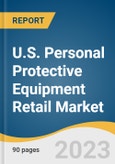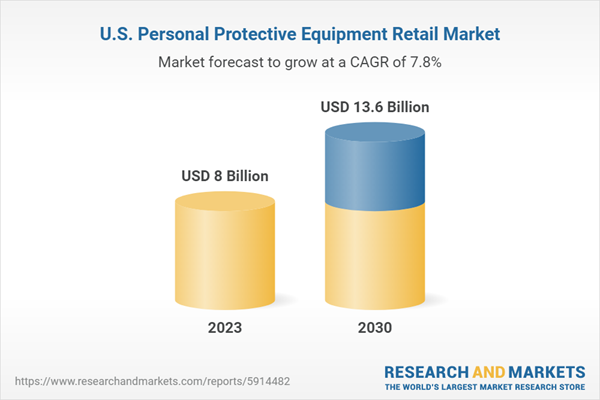The growing concerns about ensuring employee health and safety, combined with stringent occupational regulations, are likely to drive the market growth over the forecast period. Moreover, the increasing adoption of e-commerce platforms among retailers is anticipated to further drive the growth of the market.
Owing to stringent regulations such as OSHA, ISO, and others, retailers are required to ensure that the PPE products they offer comply with health and safety regulations. As regulations evolve and become more stringent, retailers are driven to stock and sell compliant PPE, leading to a wider range of PPE products in the retail market. Furthermore, stringent PPE regulations can create high entry barriers for new, unregulated PPE retailers, fostering competition among retailers that adhere to the established regulations. This can drive market consolidation and a focus on quality products.
According to the U.S. Bureau of Labor Statistics, there were 5,190 fatal workplace injuries documented in the country in 2021. The leading causes of these injuries in the construction industry included object strikes, electrocution, and falls. The lack of adequate protective equipment for workers was cited by the bureau as one of the leading causes of the fatal injuries resulting from these accidents. The adoption of stringent regulations, safety guidelines, and use of personal protective equipment has helped avoid such accidents. This adoption of personal protective equipment drives the retail market as more and more employers and organizations are expected to procure personal protective equipment from various retail channels such as online or offline.
The competitive landscape of the U.S. PPE retail industry in 2022 was marked by the presence of key industry leaders with significant influence on the market. These leaders, including Uline, Amazon, Walmart, and Walgreens, held substantial market shares, reflecting their strong market positions. To meet the rising demand from diverse industries, corporations are pursuing business growth through strategies such as mergers and acquisitions, the establishment of new manufacturing facilities, and geographic expansion initiatives. For instance, in February 2023, Target announced a plan for a USD 100 million investment to expand its next-day delivery infrastructure in the U.S. The initiative is expected to add more than six sorting centers to the supply chain of the company. This new investment is anticipated to help Target achieve its future sorting sites’ expansion thereby more than 15 facilities to be made operational by the end of 2026.
U.S. Personal Protective Equipment Retail Market Report Highlights
- Based on product, the hand protection segment dominated the market in 2023 with a revenue share of 35.0%. Workers are required to wear hand protection equipment to avoid the common hand injuries that take place in metal fabrication plants, food processing units, oil & gas refineries, and construction sites
- In terms of distribution channel, the offline distribution channel segment held the largest revenue share of 72.2% in the year 2023. The segment is expected to expand owing to the long-term existence of various traditional distribution channels, including discount stores, drug stores, hospital pharmacies, over-the-counter pharmacies, medical supply stores, hardware stores, office supplies, and sporting goods
- Based on end-use, the healthcare professionals segment held a revenue share of 22.0% in the year 2023. Healthcare professionals use PPE to safeguard themselves and patients from the spread of infections or diseases. PPE used in this area includes items like masks, gloves, gowns, and goggles and is crucial in maintaining a safe healthcare environment
- In March 2023, Amazon purchased land in the U.S. to develop its warehouses so that it can improve its supply chain robustness by offering merchandise in a short time. The company also announced a plan to expand its logistic network in the U.S. Amazon purchased a plant of Owens Corning for USD 238 million in Santa Clara to strengthen and develop its warehouse network
Table of Contents
Companies Profiled
- Uline
- Amazon
- Walmart
- Walgreens
- Target
- Staples (Sycamore Partners)
- Office Depot (ODP Corporation)
- Costco Wholesale Corporation
- Home Depot
- Lowes
- AutoZone
- CVS Health Payor Solutions
Methodology

LOADING...
Table Information
| Report Attribute | Details |
|---|---|
| No. of Pages | 90 |
| Published | November 2023 |
| Forecast Period | 2023 - 2030 |
| Estimated Market Value ( USD | $ 8 Billion |
| Forecasted Market Value ( USD | $ 13.6 Billion |
| Compound Annual Growth Rate | 7.8% |
| Regions Covered | United States |
| No. of Companies Mentioned | 12 |









